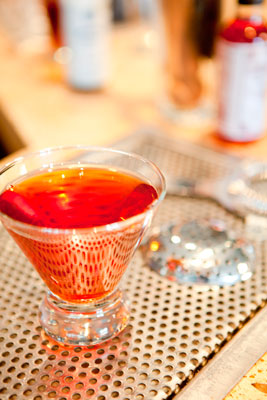 The numbers don’t lie. Total sales of liqueur and cordials declined in 2010, according to the Distilled Spirits Council of the United States (DISCUS). Value-brand sales totaled 7.4 million 9-liter cases in 2010, a 2.8% drop from 2009. Things weren’t any sunnier in the super-premium slot, in which 8 million 9-liter cases were sold, a 13% decrease from 2009.
The numbers don’t lie. Total sales of liqueur and cordials declined in 2010, according to the Distilled Spirits Council of the United States (DISCUS). Value-brand sales totaled 7.4 million 9-liter cases in 2010, a 2.8% drop from 2009. Things weren’t any sunnier in the super-premium slot, in which 8 million 9-liter cases were sold, a 13% decrease from 2009.
Does this mean you should yank the Jägermeister off the shelf? Say “no thanks” to Grand Marnier? Not in the least. Liqueurs and cordials have a very high rate of success in the hands of the right bartenders. Like most good things, liqueurs have been hurt by a slow economy, but the numbers from DISCUS are total sales, meaning retail sales for at-home consumption are included. It’s fairly safe to say that when consumers are mixing at home, only a handful of liqueurs figure into that equation.
When imbibing in a bar, club or restaurant, patrons seek a top-notch flavor experience. A savvy bartender with the right arsenal of quality, flavorful liqueurs will inspire and inform his drink offerings, which attract guests and keep them on their barstools. It’s now more important than ever to evaluate where, how and why liqueurs work in your operation.
The Status Quo
While there has been a lot of hype about esoteric liqueurs lately, rest easy: This is one category that works well with others. For the majority of venues, the liqueur and cordial selection stocked behind the bar is most operational in cocktails already on a menu and, later in the evening, highly versatile in the form of creative shooters. Cordials and liqueurs comprise about 10% of the total U.S. spirits market, and leading brands include Jägermeister, DeKuyper, Bailey’s Irish Cream, Southern Comfort and Kahlua. While it’s crucial to stock these known entities, smart operators are scrutinizing their liqueur choices more carefully than in the past, seeking styles and flavors that work best for them.
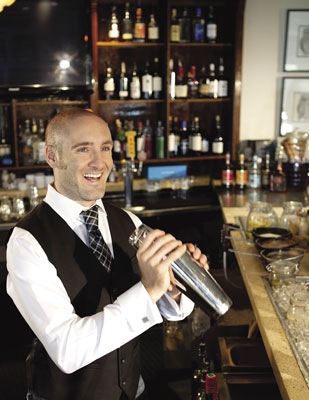
Austin Brown, bar manager at Smoke in Dallas, uses flavorful liqueurs to create interesting new cocktails to satisfy guests’ changing palates.
“We were very much on autopilot for many years with regards to our distributors and liquor reps, and I think we took one another for granted,” offers Rich Pawelczyk, chief operating officer of Webster Hall Entertainment Corp. in New York City. “They sold and we bought, and, for years, we didn’t change much.” That’s no longer the case at the company’s venues, which includes Webster Hall — a massive four-level, multi-concept nightclub and concert venue in Manhattan and winner of the 2011 Nightclub & Bar Nightclub of the Year award — a sister property called Rebel in Manhattan and a new operation, City Beer Hall in Albany, N.Y.
“The recession has reminded every business owner that costs are the No. 1 contributor to the bottom line,” Pawelczyk says. “Sales volume is great, but if you are spending $10 to make a $9.99 drink, you won’t get anywhere.”
The need to sharpen pencils pushed Pawelczyk and many like him to leverage their relationships with suppliers, looking closely at cocktail lists and the way liqueurs help sell drinks.
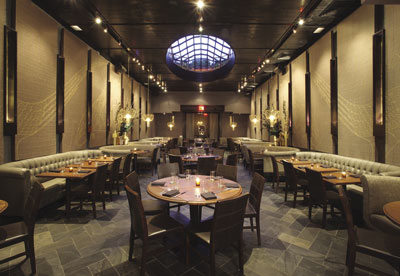
Beauty & Essex in Manhattan is a high-volume venue, so bartenders turn to liqueurs to efficiently add flavor to cocktails.
With guests coming from all over New York and the world, Pawelczyk says they “get a lot of interesting requests, and I think it’s important that we offer a lot of interesting options. Many of our guests are here on vacation, which translates to a willingness to try something new. You can see the ‘wow’ factor when we come up with cool cocktails, and it shows up in sales.”
One way he is giving guests something new is by adding a club within Webster Hall’s main room this fall. The balcony section overlooking the stage will be enclosed to create a separate, new venue, Hanky Panky. Inside, guests will find a menu of twists on classic cocktails, featuring an array of liqueurs, such as St-Germain and amaros, alongside revived pre-Prohibition liqueurs, including Rothman & Winter crème de violette. Knowing the power of major brands, Pawelczyk is giving well-known liqueur labels space on the backbar, as well.
In the main room, several bottles of Jägermeister move per week, thanks to promotions that help other products, such as domestic beer, flow more freely.
Pawelczyk says spirits are decided based on market research, what people buy among the current stock and requests from customers. “With the younger demo, I find that people drink what we — in a subtle way — tell them to. Price and promotion can make it someone’s favorite request,” he explains.
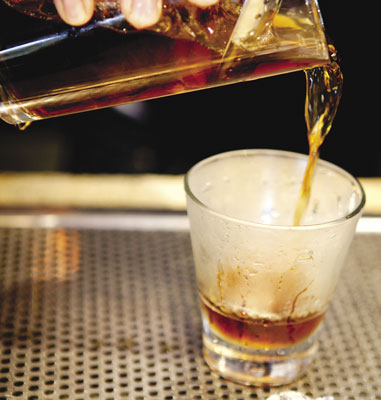 Creative Ways that Pay
Creative Ways that Pay
For Austin Brown, bar manager at Smoke in Dallas, liqueurs, cordials and bitters, such as Cherry Heering, St-Germain, Luxardo Maraschino, Aperol and Pimms, move quickly, thanks to the bar’s focus on classic cocktails. However, the bar staff still knows how to make a Kamakazi shot or a Lemondrop.
“We don’t get as many of the pre-mixed shot orders that people used to call out 10 years ago,” Brown says, “but we can still make them. When large groups come in, those orders still exist. The biggest shot trend now is just straight whiskey or tequila.”
But Brown is using liqueurs to create exciting new cocktails that also can be served in smaller shot form, such as the Aperol Inn, a combination of Aperol, lemon juice, simple syrup, John DeKuyper & Sons O3 Premium Orange and soda water. He suggests these to guests looking for direction on ordering or sends them over to loyal customers as a thank you.
“The DeKuyper O3 is sweet, but it doesn’t have the brandy or Cognac hints, which is better for our cocktails,” says Brown, who welcomes new entries from DeKuyper’s expanding portfolio. “When I came into bartending years ago, they were known for the Puckers, but it’s beyond that now. There’s a broad spectrum of flavors. The Anisette is unique. It’s a big flavor right now because of the popularity of absinthe. I use it in cocktails that call for an absinthe wash, like our Rootbeer Sazerac, or mist it on top of a drink for a different nose.”
Choosing DeKuyper Anisette checks off two important items for Brown: “There’s no high-fructose corn syrup or artificial flavors, and it saves us a ton of money. The price point is great!”
With that lower price point, Brown can stock a backbar that’s ready for any crowd; at Smoke, patrons’ palates change like the wind.
“One night might be all tequila shots and beer, the next I’m making nothing but Aperol Inns,” he says.
For Beate Kiser, a bar manager at Manhattan hot spot Beauty & Essex, the trick is to balance specialty cocktails with the speed necessary to handle the crowds.
“We cater to the masses,” Kiser says. “We want to give guests something special, but we might see 800 people in a night for dinner alone. We can’t quite do the level of crafted cocktails they have in the city’s speakeasies; those bartenders have more time to work with more ingredients. When I go out to the craft cocktail bars, I’m seeing more Chartreuse, more absinthe and more amaros going into drinks … bartenders making vermouths and bitters and really getting creative. We can’t do that with our volume, but we still want fresh and innovative products in terms of liqueurs. For example, one of our Mojitos has a measure of St-Germain in it. It satisfies the requests that we get for that product in a way that’s approachable, easy to make and fun.”
School’s in Session
Looking at the number of liqueurs available can be daunting, and simply memorizing recipes won’t help you or your bartenders make the most out of some of the more intense liqueurs, such as elderflower liqueur, allspice dram, Lillet, applejack, burdock bitters and crème de violette. If you plan on adding liqueurs to your cocktail list, it’s time to start studying. The craft cocktail movement shows no sign of slowing, and producers are banking on its continued progress into the mainstream. Many — such as St-Germain, Fernet Branca and Crème Yvette — are becoming cult classics among informed consumers, as well.
“There’s a lot of reading to be done about the classic cocktail movement now,” Brown agrees. “It’s so much more mainstream that your guests are going to know more than before and request accordingly. There are tons of books I like. Dale DeGroff’s written two, ‘The Craft of the Cocktail’ and ‘The Essential Cocktail,’ and I also like ‘Speakeasy,’ by Jason Kosmas and Dushan Zaric. Then you have the classics by people like Jerry Thomas. Since [the cocktail movement has] become more mainstream, you can find good books but also bad ones. It’s important to research the authors.”
A Brand’s Eye View
Many liquor companies are more diversified, as well. The bigger companies all have a few classic cocktail throwback brands, alongside others that work well in shooters and drinks with more mainstream appeal.
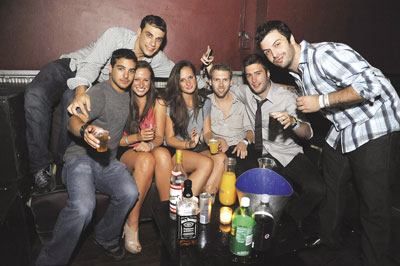
Guests from all over the world visit Webster Hall in New York City, so offering a diverse selection of esoteric and well-known liqueurs is important.
“While bartenders continue to primarily approach the liqueurs category as an ingredient in cocktails, creative bartenders are leveraging cordials/liqueurs as a simple way to add flavor to the everyday, adding a splash of flavor and color to soda, wine and even sparkling wine,” says Gail Hansche, spokesperson for DeKuyper. While DeKuyper’s Peachtree, Sour Apple Pucker, Triple Sec, Amaretto and Buttershots remain perennial favorites, newcomer O3 Premium Orange — launched in April 2011 — is taking off, she notes. Additionally, John DeKuyper & Sons Crave Luscious Chocolate Liqueur will be available Oct. 1 in select markets.
“From Hpnotiq to PAMA Liqueur to Cynar, we represent a broad cross-section of brands,” offers Heaven Hill Corporate Communications Manager Joshua Hafer. “Our top liqueur sellers are Hpnotiq Liqueur and PAMA Liqueur. But some of our newest products have hopped on the flavor trend by incorporating familiar flavors with traditional bases. For instance, Christian Brothers Honey, Evan Williams Honey and Cherry Reserves and Hpnotiq Harmonie have been extensions of top-selling products, which are extremely hot right now.”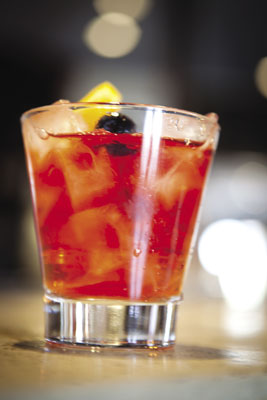
Revival is a common theme. One of the world’s oldest liqueurs is a must-have among the craft cocktail bar set. “Chartreuse is still considered a niche brand,” says Tim Master, director of specialty spirits and trade education for Frederick Wildman and Sons, Ltd. “But we have seen double-digit growth in the last 10 years. Some larger chain restaurants are getting into the high-end cocktail craze. This has certainly helped Chartreuse gain exposure with bartenders and operators outside the niche cocktail bars.”
DeKuyper Royal Distillers, one of the oldest family distilleries in the world, is expanding its offerings; a hot addition is Mandarine Napoléon, launched in 2008. A blend of mandarin oranges and 10-year-aged Cognac, the spirit is getting rave reviews from globally recognized spirits authorities, such as Simon Difford, founder of CLASS Magazine and author of “diffordsguide — Cocktails.” It’s proving that even the oldest companies and brands still see new ways to inject flavor into the liqueurs market; with all of the creative manpower behind the bars these days, the sky is the limit on creating innovative drinks.
“The biggest challenge [to growing liqueur sales] is education,” adds Robert Cooper, creator of St-Germain and reviver of the original formula for Crème Yvette. “That said, we are steadily attacking it head on.”
That sentiment echoes how many industry pros feel about the category overall: It’s a broad one that can be tough to get your arms around, but for bartenders who do their research and find liqueurs that fit with their clientele and drink-making style, it provides a bright, flavorful impetus for excitement, profits and growth. NCB
